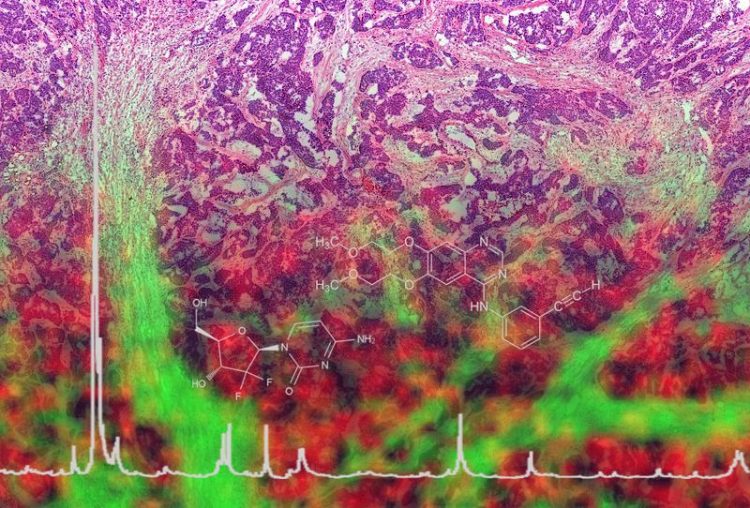Innovative tissue analysis: Munich spin-off project receives Helmholtz funding

With the new technology a kind of molecular map can be created. Source: Helmholtz Zentrum München
Examining tissue samples is an essential tool for investigating diseases and is a mainstay in the field of diagnostics. Conventionally, tissue is fixed, sliced into thin sections, placed on a microscope slide, stained and examined under a microscope. Besides tissue structures, individual molecules can also be marked and visualized.
“However, mass spectrometry imaging can augment the information content of such tissue sections to cover thousands of analytes in situ*,” explains Prof. Axel Walch, Head of the Research Unit Analytical Pathology at Helmholtz Zentrum München.
For mass spectrometry imaging, a tissue slide is raster-scanned with a laser and at each point a mass spectrum is recorded. The recorded spectra represent the information of the individually measured molecules site-specifically in the tissue.
From the totality of the spectra a kind of molecular map can be created. Now, the funding is intended to lead to the widespread use of this technology. “The focus will be on new diagnostic and pharmacological tests to improve the treatment of cancer patients,” explains applicant Dr. Achim Buck. “Our goal is to bring about a change in the approach to tissue-based diagnostics and research.”
Improved treatment of cancer patients
The team led by Axel Walch sees a range of applications for the new analytical method, as it can be used to visualise and objectively measure both endogenous and exogenously introduced substances in the body. “For example, we’re able to detect drugs and their degradation products in tissue,” Achim Buck explains.
“Currently, much of what we know about pharmacology, toxicity, pharmacokinetics and drug interactions is gained from the study of surrogates, such as blood samples or tissue homogenates**. While this approach is pragmatic, it does not reflect the actual molecular situation in the tissue.“
In addition, the imaging experts are able to identify molecular patterns relevant to specific diseases. Therefore, they see potential applications in the fields of drug analysis, diagnostics and therapy prediction in personalized medicine.
The latter aims to base treatment decisions on predictive markers and to tell in advance whether a patient will respond to a treatment. “The site-specific detection of previously undetectable, treatment-relevant molecules can set new standards in diagnostics,” Achim Buck concludes.
The Helmholtz Association is funding the spin-off through the Helmholtz Enterprise Programme with 100,000 euros. A further 100,000 euros will be contributed by Helmholtz Zentrum München.
Further Information
* In situ (Latin for “on site”) is a Latin term meaning “in the original position”. Specifically, it refers to the natural spatial distribution of molecules in tissues.
** Tissue homogenate: Tissue is destroyed by physical or chemical comminution, and its cellular contents (homogenate) are released. Although this allows analysis of the cellular components, the spatial distribution of individual molecules in the tissue is lost.
The Helmholtz Zentrum München, the German Research Center for Environmental Health, pursues the goal of developing personalized medical approaches for the prevention and therapy of major common diseases such as diabetes and lung diseases. To achieve this, it investigates the interaction of genetics, environmental factors and lifestyle. The Helmholtz Zentrum München is headquartered in Neuherberg in the north of Munich and has about 2,300 staff members. It is a member of the Helmholtz Association, a community of 18 scientific-technical and medical-biological research centers with a total of about 37,000 staff members. http://www.helmholtz-muenchen.de/en
The independent Research Unit Analytical Pathology (AAP) carries out scientific development, as a complement to research units with a clinical and fundamental orientation, of translational research on diseases that occur in tissue. AAP is involved in the translation of (for example) in-vitro models or animal models to application in humans. AAP thus links basic research with diagnostic application, subsequently translating the findings of experimental and molecular pathology into procedures for the classification of diseases and predictive diagnostics dealing with tissue. http://www.helmholtz-muenchen.de/aap
Contact for the media:
Department of Communication, Helmholtz Zentrum München – German Research Center for Environmental Health (GmbH), Ingolstädter Landstr. 1, 85764 Neuherberg, Tel. +49 89 3187 2238, E-mail: presse@helmholtz-muenchen.de
Scientific Contact:
Dr. Achim Buck, Helmholtz Zentrum München – German Research Center for Environmental Health (GmbH), Research Unit Analytical Pathology, Ingolstädter Landstr. 1, 85764 Neuherberg – Tel. +49 89 3187-4133, E-mail: achim.buck@helmholtz-muenchen.de
Prof. Dr. Axel Karl Walch, Helmholtz Zentrum München – German Research Center for Environmental Health (GmbH), Research Unit Analytical Pathology, Ingolstädter Landstr. 1, 85764 Neuherberg – E-mail: axel.walch@helmholtz-muenchen.de
Media Contact
All latest news from the category: Awards Funding
Newest articles

“Nanostitches” enable lighter and tougher composite materials
In research that may lead to next-generation airplanes and spacecraft, MIT engineers used carbon nanotubes to prevent cracking in multilayered composites. To save on fuel and reduce aircraft emissions, engineers…

Trash to treasure
Researchers turn metal waste into catalyst for hydrogen. Scientists have found a way to transform metal waste into a highly efficient catalyst to make hydrogen from water, a discovery that…

Real-time detection of infectious disease viruses
… by searching for molecular fingerprinting. A research team consisting of Professor Kyoung-Duck Park and Taeyoung Moon and Huitae Joo, PhD candidates, from the Department of Physics at Pohang University…





















